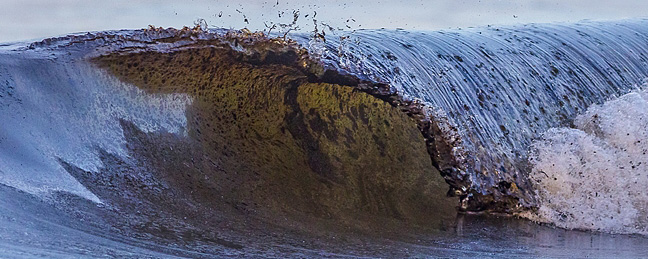
Lasting impression: As southern Santa Barbara County beaches get cleaner, what can we make of the Refugio spill?
by Sean McNulty
reprinted from the Santa Maria Sun. June 25, 2015.
Work crews removed thousands of feet of yellow boom from the beach at Refugio State Beach the weekend before Father’s Day. According to the Unified Command in charge of cleanup, oil hadn’t been seen on Santa Barbara Channel’s surface in several days. Ten rehabilitated pelicans, some outfitted with tracking devices, were released on June 12. The rocks were scrubbed free of oil with wire brushes. Hundreds of pounds of oily sand and soil was hauled away in plastic bags.
Refugio is the unlucky spot on which Plains All American’s Line 901 spewed more than 100,000 gallons of crude oil. The line is a buried 24-inch steel pipe linking the Gaviota Pump Station to the refinery at Las Flores Canyon. It ruptured on May 19, oozing carbon sludge down the hill, under the freeway, and onto the beach. The stink tipped off the neighbors, but it was too late. The oil was already in the ocean, and it was spreading north and east with the currents.
An estimated 20,000 gallons of crude made it into the ocean. The slick expanded to 11 miles over the next few days, stretching south and east. In the weeks to come, blobs of tar would show up past Point Mugu in Malibu and start washing ashore in Long Beach. The cleanup effort has thus far cost $3 million a day and has no estimated end date. Hundreds of birds, mammals, and an untold number of other living things have been killed. Fisheries remain closed. Beaches are cleaner, but the amount of oil still floating in the ocean is unclear.
The first signs of trouble came at the Midland Control Center in Texas, a Plains employee detected “pressure anomalies” in Line 901 around 11:30 a.m. that May 19 morning. Around 11:45 a.m., Santa Barbara County Fire Engine Crew 18 called off an oil response drill it was conducting with the county Office of Emergency Management at the Freeport-McMoRan facility about 2 miles away to respond to 911 calls about a strong petroleum smell.
Around 12:30 p.m., they found oil on the beach and a 1/4-mile slick on the water. They notified dispatch and followed the spill up the hill. They traced the oil back to where it was spilling from the pipe, down the hill, through a culvert, under Highway 101 and the train tracks, through the estuary at Refugio, across the shoreline, and into the ocean.
A Plains employee confirmed the release an hour later, at 1:30 p.m. A two-man team from the U.S. Coast Guard, as well as responders from Clean Seas and the Department of Fish and Wildlife, arrived at about 2:30 p.m. The National Response Center was notified at 2:56 p.m. The response was officially underway.
Line 901
The oil in Line 901, according to the National Oceanic and Atmospheric Administration, was a blend of crude drawn up by the platforms Heritage, Harmony, Hondo, and Holly. They sit on the outer continental shelf of the Santa Barbara Channel above 800 to 1,200 feet of water. The blend of oil running through Line 901 is sulfurous and heavy.
Miyoko Sakashita is the director of oceans for the Center for Biological Diversity. She said that the oil spilled from Line 901 will stay in the channel’s food web for a long time.
“A little bit of oil will get buried in the sand on the coast, and it will remain there for years,” she explained. “Animals at the base of the food web are exposed to those contaminants. The government predicted when they approved this pipeline that an oil spill could have impacts for two years, even an oil spill right smaller than this one,” she continued.
Five different endangered species of whale, including the blue whale, forage and migrate through the Santa Barbara Channel. Sea lions, dolphins and elephant seals swim there as well. More than 500 species of fish live in the channel. They share the water with octopi, lobsters, and shrimp. Corals and anenomes populate the sea floor.
The Surfrider Foundation has educational materials detailing the damage oil does to animals: It permeates the plumage of birds, rendering them unable to fly or stay afloat in the water and ruining their insulation. The birds injest oil when they try to preen it from their feathers, and that oil damages their kidneys and liver. Marine mammals exposed to oil have trouble regulating their body temperature. Injested oil can lead to dehydration, digestive damage, and trouble breathing.
“As animals eat prey that’s contaminated, they start to accumulate the contaminants in their body tissue,” Sakashita said. “Over time, those contaminants become very severe. With whales, one of the threats that remain are contaminants which remain in the environment decades later. One of the key species is the snowy plover. We know that the oil has reached their nesting area and they have been returning with oil on their feathers.”
Delayed response
Line 901 wasn’t an underwater pipe, which is why Kira Redmond, director of the organization Santa Barbara Channelkeeper, thinks the oil shouldn’t have made it to the ocean. She and others claim the response to the spill was too slow.
“The spill happened on the other side of the freeway, onshore, and that at least a fifth of the oil got into water and that it wasn’t stopped until three hours after, indicates that there is a problem,” she said.
State Assembly member Das Williams (D-Santa Barbara), speaking to press in a conference call, said that the Unified Command acted with “alacrity” and was “very forthcoming with information.” Still, he added that certain aspects of the response had been underwhelming.
“If they’re going to say they have resources available and take five hours to respond, that’s an unacceptable amount of time to reach the spill,” he said.
Redmond also indicated that access to the spill was initially tightly controlled for agencies such as hers with a stake in the cleanup.
“It’s understandable,” she said. “They want to get the cleanup job done with trained staff. But we’re an organization that has some expertise, some of our staff has hazardous materials training, and we have the resources to really help. We’ve been trying.”
State Sen. Hannah-Beth Jackson (D-Santa Barbara) added that it was shortsighted to turn away civilian first responders who showed up to help before the official response was underway.
“They want to be there; they want to help,” she said. “Part of what we saw was an enormous number of people wanting to be of assistance. A stitch in time saves nine.”
On May 20, Gov. Jerry Brown declared a state of emergency. Plains All American coordinated with the Department of Transportation—through which the federal government regulates pipelines—and the Coast Guard, the Environmental Protection Agency, the California Office of Emergency Services, the Department of Fish and Wildlife, and the Santa Barbara County Office of Emergency Management to create a “unified command” that would oversee cleanup efforts.
Bizarrely, he also moved to suspend key provisions of the California Coastal Act, which is the reason why the Coastal Commission exists. Linda Krop with the Environmental Defense Center called the suspension of the Coastal Act unprecedented and frustrating.
“The Coastal Act is the strongest environmental law in place. … Not having the Coastal Act be part of the response is a huge gap,” she said.
Sakashita with the Center for Biological Diversity also protested the suspension of the Coastal Act, pointing out that certain provisions of the Act outline what to do in an emergency.
“The governor was waiving important protections. The effect is really that as they’re doing restoration and trying to make sure that impacts are mitigated, it removes the authority of the Coastal Commission to really oversee that process,” she said.
The governor’s office, under pressure from watchdog groups, restored the provisions, but didn’t return the Sun’s request for comment.
Here piggy, piggy
In the wake of May 19, several environmental groups asked why the leak took so long to identify and stop. The official investigation is continuing, and it still isn’t clear why the leak wasn’t found earlier. In a factsheet, Plains said it inspects its pipelines by air every week. Line 901 was scanned with a pig—basically a robot that looks like a dumbbell and is designed to check pipes for problems—in 2012 and again just a few weeks before the accident.
Pigs move down the inside of a pipeline and use an array of sensors to scan for potential issues. Carl Weinman, the director of the Pipeline Safety Trust, said the trove of data produced by the pig takes time and effort to decode—weeks or even months.
“A thousandth of an inch could show up in a smart pig run,” he said. “You need to run that data through a computer system to figure out what things are a problem and what aren’t.”
Part of the data from the recent pig run was recently released to the public. The feds issued a corrective order and laid out initial findings on June 3. Plains’ non-destructive contractors measured a 74 percent loss of the metal in certain sections of the pipe. Third-party metallurgists said the walls of the pipe had been worn down even further, to 1/16 of an inch where the leak was. They said external corrosion of the pipe “at this level would not be expected” with the protection measures that were in place.
In short, the pipe was worn down on both the inside and the outside in surprising ways.
Every pipeline in Santa Barbara County is equipped with automatic shut-off valves in the case of a breach. The Santa Barbara Independent reported that 901 is the only pipeline in the county without that key safety feature. In the case of last month’s emergency, it took two hours to manually shut down the pipeline.
That’s the fruit of a 1988 case where Celeron All American successfully challenged the county in federal court, shutting the county out of the regulatory process for that pipeline. The county’s rules requiring automatic shut-off valves were waived.
Plains All American said in a press release that it “was not prudent” to install the automatic valves on Line 901: “Automatically closing a valve on an operating pipeline such as this would increase the pressure which could create an unsafe situation.”
Assembly member Williams doesn’t buy that argument. “That doesn’t take into account their current level of engineering expertise,” he said. “Automatic shut-off valves would increase pipeline safety, and they have the capacity to engineer for pressure changes that would be created by such valves.”
Kevin Drude, who heads the county’s energy division, said because of that 1988 case, 901 is “the only pipeline whereby the county is preempted from monitoring and safety inspections.” He speculated that the decision may have been made to make things simpler from a regulatory perspective.
“It’s always better to have one set of eyes and one billing machine,” he said.
Without the county involved, it fell to the federal government to keep an eye on Line 901. Until 2013, they did so through the California Fire Marshal’s Office. According to Sen. Jackson, resources at the Fire Marshal eventually dried up, the state backed out, and the feds were left to inspect the pipe on their own. But a bill she recently introduced aims to change that.
“We didn’t have enough trained personnel,” she said. “The oil companies would offer [the inspectors] two or three times the money to go and work for them. So we didn’t have enough state people in order to do the job. This bill is hoping to put some financial teeth into this.”
History of breaks
At one point, the oil running through 901 might have been transported by ships. But the environmental community pushing to protect the south coast of Santa Barbara County in the wake of the 1969 oil spill pushed to consolidate oil production into the relative safety of pipeline transport, according to The Independent.
Plains saw $43 billion in revenue and $878 million in profit in 2014, according to The Los Angeles Times. Some of this comes from the pipelines they operate in California. Data on the website of the Pipelines and Hazardous Materials Safety Administration (PHMSA) indicate that the company operates 480 miles of hazardous liquid pipeline in the state, out of roughly 6,500 miles nationwide.
Federal records show Plains racked up some 8,000 serious pipeline breaks since 1986. Only four of the 1,700 pipeline operators in the PHMSA database can boast more incidents. An analysis of those incidents commissioned by the Center for Biological Diversity found nearly one third of the incidents were caused by corrosion or other spontaneous structural failures. The tab for property damages incurred because of breakage totals roughly $7 billion dollars. Records also show 2,300 injuries. That’s an incidence roughly 11 percent higher than the industry average.
NBC4 in Los Angeles dug up an EPA settlement from 2010 where Plains was held to account for 273,000 gallons spilled in Texas, Louisiana, Oklahoma, and Kansas. Most of the incidents were related to corrosion. Plains paid out millions in civil penalties and agreed to spend more than $41 million to improve its infrastructure.
Here to stay
Oil has done the county bad before. A blowout on a rig in the Santa Barbara Channel cut loose 4 million gallons of crude, blanketing the coast from Santa Barbara to Carpintaria with 200 miles of oil. Paul Relis, who wrote about his experience with the 1969 spill in his recently published book Out of the Wasteland, said the cleanup was a disaster.
“They showed they were completely incompetent addressing the cleanup. They really didn’t know what to do,” he said. “They hired people to spread straw and use pitchforks.”
In light of the 1969 spill, he said, the response to the Line 901 disaster is much more muscular. Still, he worries that the effects of the spill could be felt on the scale of history.
“There will be long term consequences,” he warned. “I don’t like the way this is being handled, as a citizen who went to UCSB and surfed El Capitan and considers it one of the great coastal resources in the United States. To me it’s a sacred spot. That shoreline had not been damaged like that for untold centuries. Thousands of years.”
And the oil business, already big in Northern Santa Barbara County, is looking to get bigger. There’s the much-discussed Phillips 66 rail spur, of course, which would bring several more trains a week through Santa Barbara County transporting crude oil for refining. That project, currently swamped between drafts of environmental impact reports, has spilt plenty of ink already.
Other projects are proposed for Cat Canyon. Aera Energy is looking to revive more oil production in Cat Canyon with some 300 wells—half for oil production and half for exploration or steam injection. Aera hopes to produce as many as 10,000 barrels a day at full production.
Cat Canyon would be linked through the Foxen Canyon pipeline, an ERG Resources project that will run almost 3 miles, cross five streams, and cut through habitat of sensitive species such as the California tiger salamander and California red-legged frog. The pipeline, unlike Line 901, would be monitored by a SCADA leak detection system. Like 901, it would ward off corrosion through a “sacrificial anode system” of electric cathodes.
These new projects come alongside legislation proposed to prevent future spills and sharpen the response to them. Sen. Jackson, through legislation, hopes to restore a rapid response and reinstate the California State Fire Marshal’s Office into the inspection process. Through SB 788, she’s also pushing for an oil drilling ban on Tranquillon Ridge off the Santa Barbara Coast.
“When the bill for this drilling was written, we didn’t know there was oil in a protected marine area,” she said in a conference call with press. Jackson saw a similar bill die in the face of intense opposition last year.
Assembly member Williams hopes that regulating valves is “not federally preempted,” and that California can impose automatic shut-off valves as a statewide requirement, even in the case of pipelines that run through multiple counties or states.
For Dan Menscher, an attorney who litigated the BP Deepwater Horizion spill and is now bringing damages against Plains in a class action lawsuit, the spill isn’t a matter of the future or the past, necessarily, but a question of the livelihood of his clients—who make a living off fishing or harvesting in the channel—today.
“You’re a fisherman who’s expecting to go out and catch fish in an area that’s closed, and he can’t. He’ll be losing money and opportunity costs and stuff like that. There aren’t that many places that are great for sea urchin harvesting,” he said. “Oil companies like to say ‘look, it’s all cleaned up!’ That oil is probably down on eel grass beds. These things have long-lasting harm. Some of it is obvious, some of it might not be.”


![Santa Barbara Museum Of Natural History Board Of Directors. Photo By Jllm06 (Own Work) [CC BY-SA 3.0 (http://creativecommons.org/licenses/by-sa/3.0)], Via Wikimedia Commons](https://paulrelis.com/wp-content/uploads/2016/01/Santa_Barbara_Museum_of_Natural_History_-_exterior-200x200.jpg)


This Post Has 0 Comments